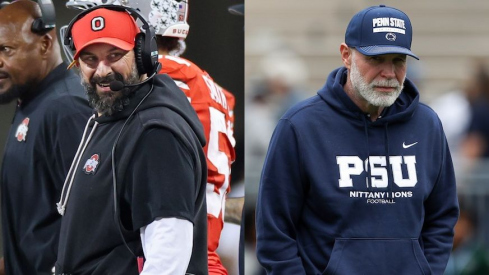
Ohio State's second bye week provides the opportunity to examine an issue on the forefront of opposing coaches' minds – how can a defense go about defending an increasingly prolific Ohio State offense?
I will examine the question through the prism of how potential Big Ten Championship opponent, Michigan State, may use its aggressive cover 4 defense to accomplish this mission.
First things First
It is difficult for any defense to adequately defend Ohio State without devoting an additional defender against the Buckeye run game. This begins with the Ohio State offensive line and Carlos Hyde, but is also on account of Braxton Miller. Miller's running ability alters a defense's numeric advantage, forcing the defense to not just account for an additional potential ball carrier, but one that is a threat to create explosive plays.
To take a step back, a defense has a one man numeric advantage – the counterpart to the offensive player with the football. Once the quarterback hands off, the defense gains a two-man advantage. But Miller's ever-present threat to run not only negates this additional man advantage, but forces a defense to game plan to defend the quarterback run threat.
Thus, if Ohio State is in its basic 11 personnel (3 WR, 1 TE, 1 RB), the defense must account for eight offenders in the box while also defending four immediate vertical threats. The defense's most immediate concern, though is Hyde and Miller. A defense cannot allow itself to be gashed on the ground and thus must seek to regain its numeric advantage by cheating an additional defender against the run. The defense's ultimate goal is to get its unblocked defender closer to the line of scrimmage.This generally comes in the form of a safety playing the run or the slot defender cheating into the "gray area."

Whittling Down
The two most basic ways a defense applies an additional defender against the run is by playing cover 1 robber or cover 4. Both allow a defense to insert one or both safeties against the run game.
The Alabama-Texas A & M game earlier this year is instructive. While Texas A & M's air raid offense differs from Ohio State's, the need for the Crimson Tide to defend Johny Manziel as a runner required Alabama to get an additional defender near the line of scrimmage to account for the quarterback.
To do so, Nick Saban and Kirby Smart primarily played cover 1 robber so that a) Alabama's strong safety could come into the box, and b) the Crimson's Tide's middle linebacker was free to effectively be a middle of the field spy. It should be noted that Alabama's defense was not particularly successful against the Aggies, however, as Manizel was able to exploit outside man coverage and scramble with defensive backs locked in man coverage..
Matching Up
Defenses generally seek to utilize a similar strategy against Ohio State. But the Buckeyes have exploited this formula in recent weeks, attacking the edge and down the field in areas vacated by defenders concerned with the run. This does not mean, however, that it is necessarily the incorrect strategy. Defenses have to pick their poison and the better option is still trying to limit the Buckeye run game.
But what it does mean is that a defense needs the defensive backfield talent necessary to allow the defense to devote additional defenders against the run game. The Buckeyes have very good receivers led by Corey Brown and Devin Smith. But they are not necessarily elite talents and can perhaps be manned up by very good corners. A defense's best chance against the Buckeyes is if they can limit the easy passing yards Ohio State has been gaining in recent weeks with their defensive backs while still devoting resources to the run game.
The Narduzzi Experiment
Enter Michigan State. Mark Dantonio and Pat Narduzzi have built one of the country's best defenses, a defense predicated upon defending the spread to run offense. The basis of the Spartan defense begins with aggressive cover 4 pattern matching coverage. As I have previously discussed, cover 4 means that the defensive backs split the field into fourths.

Though at first glance cover 4 sounds like a conservative coverage, it is actually quite aggressive as it allows a defense to apply both safeties against the run game and employs man coverage principles.
The safeties read the number 2 receiver to their side of the field. If the receiver blocks, the safety comes downhill against the run. If they release vertically, the safeties will play the receivers in man coverage. And if the receiver breaks in or out, the safety will pass that receiver off inside or outside, expecting that another receiver will appear in their area. The coverage is thus effectively the equivalent of matchup zone in basketball. This allows the defense to apply its unblocked safeties against the run, while also being able to quickly respond to four vertical routes from spread offenses.
But Narduzzi takes cover 4 and puts it on steroids. With typical cover 4, the corners often align at the same depth of the safeties (see Iowa above). But for Michigan State, the corners often play press coverage. They rarely receive bracket help from the safeties and are generally manned up outside. The Spartan defense is thus very reliant on physical, aggressive cornerback play, led by Darqueze Dennard.
This frees the safeties to play more aggressively against the run, often aligning inside ten yards.

With their cover 4 established in the secondary, the Spartans employ several common tactics up front from their base 4-3 over defense. Michigan State employs a regular scrape exchange with their defensive end and linebacker against the zone read, generally cheating the walked out linebacker into the gray area. The Spartans also deploy two regular blitzes – a double A gap linebacker blitz and a blitz from their boundary corner. The latter is another method to attack the mesh point of the read run game.
Every Theory has Limits
Even though Michigan State's defense is designed with the spread in mind the plan is not foolproof. A much more limited Ohio State offense proved that last season, generating enough points to win a close game in East Lansing. Urban Meyer and Tom Herman made blocking adjustments that exploited the Spartans' scrape exchanges, getting Miller outside contain. Smith was then able to beat Michigan State's man corner down field for a cruical score. Once Michigan State was stretched horizontally Ohio State was able to run Hyde inside to seal the game.
The 2013 Buckeye offense is far more diversified in its play calling and execution. Expect Ohio State to seek to utilize a similar game plan as it has in recent weeks. The Buckeyes will likely seek to stretch the Spartans horizontally, exploiting outside linebackers cheating off the inside wide receiver with the outside screen game, and then take advantage of the aggressiveness of the Spartan safeties with play action off read plays such as inverted veer.

With tight end Jeff Heuerman staying in to block and a pulling guard showing run, the play action makes it extremely difficult for the cover 4 safety to read his keys.
Then, once a defense is forced to play the Buckeyes more honestly, the Buckeyes will turn to Miller and Hyde in the run game.
The Ohio State offense is too good and diversified to stop. But if any defense has the ability and design to slow down the Buckeye offense, it is Narduzzi's Spartan defense.

